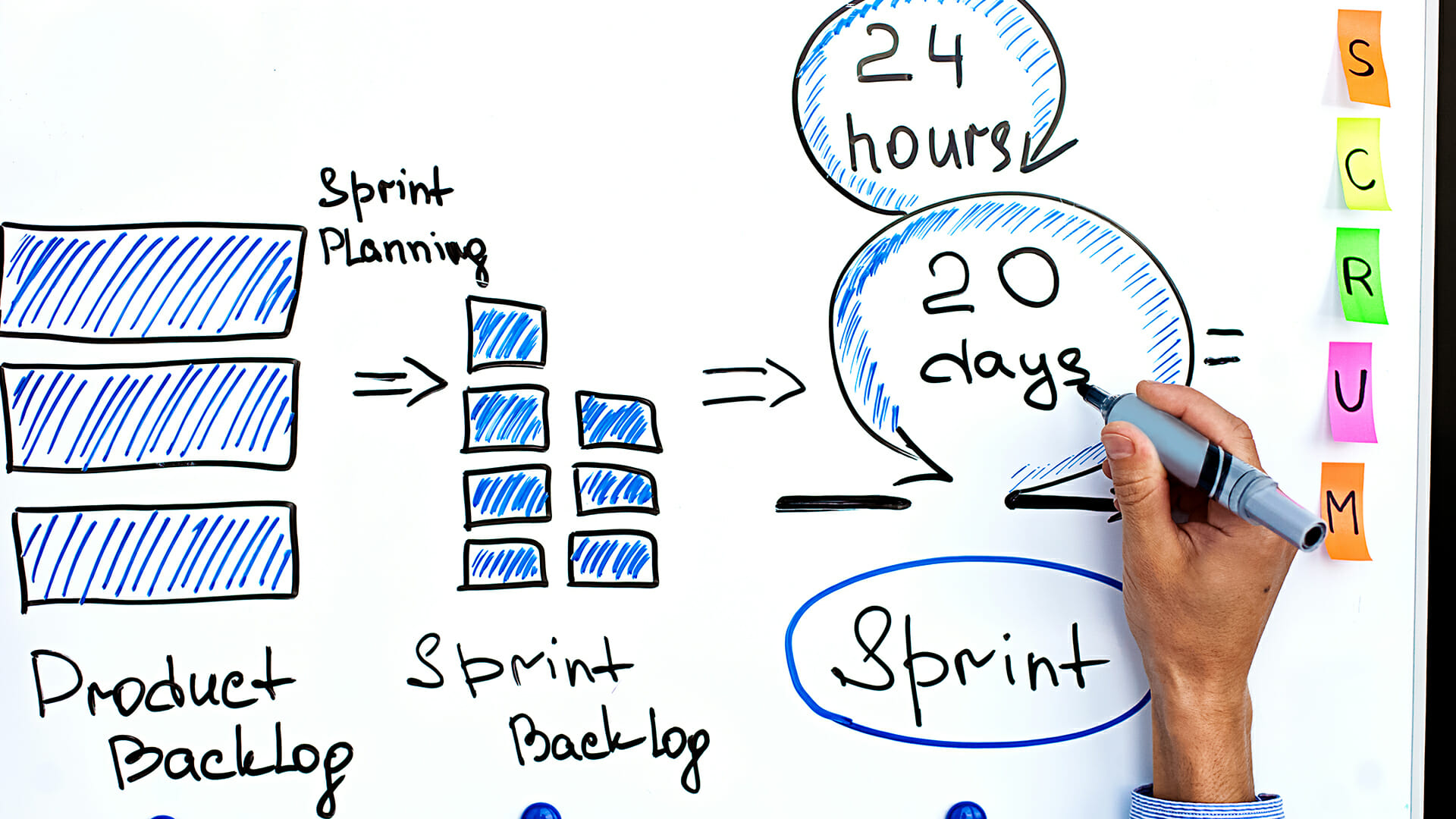
For the past few weeks, we’ve been sharing chapters from MarTech’s Guide to agile marketing for teams, a comprehensive e-book that takes a look at how teams can best execute in an agile marketing playbook.
But like any good discipline, it’s important to know the terms before diving into the concepts. That’s why we’ve created this quick guide to key terms in agile marketing. And in order to keep this guide usable when you are in quick need of a definition, we’ve kept it to the truly important terms.
The glossary is divided into four sections: Methods and Frameworks; Roles; Artifacts (which is the agile term for “tools”); Meetings; and Managing Work.
Enjoy the guide.

Many marketers struggle to apply agile marketing in a way that adds value to team members. Learn how to break that pattern in this free e-book, “MarTech’s Guide to agile marketing for teams”.
Methods and Frameworks
Agile
Agile is the ability to create and respond to change. It is a way of dealing with, and ultimately succeeding in, an uncertain and turbulent environment.
Agile Marketing
Agile marketing is an umbrella term for a set of frameworks and practices based on the values and principles expressed in the Agile Marketing Manifesto. When you approach marketing in a particular manner, it’s generally good to live by these values and principles and use them to help figure out the right things to do given your particular context.
Kanban
The Kanban Method is a means to design, manage, and improve flow systems for knowledge work. The method also allows organizations to start with their existing workflow and drive evolutionary change. They can do this by visualizing their flow of work, limiting work in progress (WIP) and stopping starting and starting finishing instead.
Lean Marketing
Lean Marketing is about being agile, about viewing each campaign or marketing activity as one step in the ever-improving progress towards customer acquisition and ultimately customer satisfaction.
Scrum
Scrum is a process framework used to manage product development and other knowledge work. Scrum is empirical in that it provides a means for teams to establish a hypothesis of how they think something works, try it out, reflect on the experience, and make the appropriate adjustments. That is, when the framework is used properly. Scrum is structured in a way that allows teams to incorporate practices from other frameworks where they make sense for the team’s context.
The Agile Marketing Framework
This is was recently created to meet the unique needs of marketing organizations. It’s inspired from the common frameworks of Scrum, Kanban & Lean, taking the best of all three into a formula that marketers find most useful based on real customer experiences.
Roles
Agile Champion This role from The Agile Marketing Framework is about coaching the team and the organization on agile ways of working. This role is not there to project manage work, but rather to empower teams to take ownership and accountability.
Agile Coach is someone brought in, typically from outside the organization, to help your organization enhance it’s agile practices and live out the values and principles of agility.
Marketing Owner is a role that’s responsible for stakeholder relations and prioritization of work. This role has authority and respect from leaders to determine what the team will work on next. This role also updates the Marketing Roadmap and Content Calendar as priorities change. This role often is given to a Marketing Strategist who understands customers, the marketplace and the future direction of work.
Marketing Team
Everyone contributing work is a member of the Marketing Team, despite their official job title. Ideally, there is no hierarchy within the team, allowing for ideation by all team members. In agile marketing, team members have broad skill sets and are able to go beyond their specialties to work on business priorities.
Practice Leads
These are leaders of functional departments. In agile marketing, their role changes significantly. They no longer manage their employees’ work, but instead lead the functional area to achieve optimal quality and best practices.
Product Owner
The product owner is a role in Scrum responsible for managing the product backlog in order to achieve the desired outcome that a team seeks to accomplish. The product owner role was created as part of the Scrum framework in order to address challenges that teams had with multiple, conflicting direction, or no direction at all with respect to which work is the most important to the business and customers.
Scrum Master
This is the team role in the Scrum framework responsible for ensuring the team lives agile values and principles and follows the processes and practices that the team agreed they would use. The role does not generally have any actual authority. People filling this role have to lead from a position of influence, often taking a servant-leadership stance.
Scrum Team
Same as “Marketing Team” used in the Scrum framework.
Stakeholders
These are people invested in the work that the marketing team produces such as Sales, Product Development and Customer Service representatives.
Artifacts
Content Calendar
If your marketing team creates content, you may have a need to schedule when each piece gets published. Having fixed content release dates will still be agile, as long as you can be flexible on some of the details that you put in your content, iterating and revising as you learn more from earlier pieces.
Marketing Backlog
The Marketing Backlog is a place where all of the team’s ideas for future work lives and is transparent to everyone. The backlog is emergent and flexible, changing continuously as campaign data and metrics inform the team on which ideas to move up in prioritization and which ones should not be worked on anymore because they didn’t perform as expected.
Marketing Roadmap
A timeline of anticipated delivery of campaigns to clients that is typically for a quarter at a time, but is reviewed regularly by marketing owners and stakeholders and is subject to change as market and customer demands shift.
Product Backlog
Scrum Term for “Marketing Backlog” typically referring to future work to develop a product.
Sprint Backlog
The set of product backlog items in Scrum selected for the sprint by the team, plus a plan for delivering the committed work.
Meetings
Backlog Readiness
This should happen as needed to make sure that the team’s Marketing Backlog has enough detail to discuss how work will get done during planning. However, it’s important to move quickly and don’t get too deep into the logistics as agile is about switching gears up until the time the team begins work.
Backlog Refinement
Scrum term for “Backlog Readiness”, formerly known as “Backlog Grooming”.
Campaign Performance Review
This session is for the team and stakeholders to look at how campaigns in market are performing, using data and insights to inform future work. The team will also showcase any new work done that cycle that’s ready to launch. Finally, the marketing roadmap should be reviewed based on these findings and updated based on market performance, new customer insights or marketplace changes.
Daily Huddle
This is a time for the team to coordinate timing on work in progress, share any updates on feedback from campaigns in flight and to ask for help from team members. This should feel more like a football team huddling to make its next play than a status update. The Daily Huddle is for team members to talk to each other and to keep themselves moving forward with their planned work.
Daily Scrum
Similar to the Daily Huddle, the Scrum team inspects the progress toward the sprint goal and adapts the sprint backlog as necessary, adjusting the upcoming planned work. Maximum of 15 minutes each day.
Launch Planning
This is where the team collaborates and plans for the work they hope to launch in a 5 or 10-day cycle. The goal is for everyone on the team to commit to what work they plan to accomplish and how they’re going to work together to achieve that goal. Good Cycle Planning involves synchronizing the timing around work and understanding everything involved to deliver something of value to customers.
Sprint
A timeboxed, consistent period that the team works with minimal interruptions to meet its goal of getting committed work items done. A marketing sprint is either one or two weeks, maintaining consistency in the length.
Sprint Planning
Sprint planning is an event in the Scrum framework where the team determines the product backlog items they will work on during that sprint and discusses their initial plan for completing those product backlog items. Teams may find it helpful to establish a sprint goal and use that as the basis by which they determine which product backlog items they work on during that sprint.
Sprint Retrospective
The Scrum team inspects how the last sprint went regarding individuals, interactions, processes, tools, and definition of done. The Team identifies improvements to make the next sprint more effective and enjoyable. This is the conclusion of the sprint.
Sprint Review
The entire Scrum team inspects the sprint’s outcome with stakeholders and determines future adaptations. Stakeholders are invited to provide feedback.
Team Improvement Workshop
This is a collaborative session for team members to look at continuous improvement. The goal is to find a small action item that the team can implement in the coming cycle to improve how they work together. Reflecting back at the most recent cycle may help the team learn from actual events.
Managing Work
Big Goals (or Big Hairy Audacious Goals, or B.H.A.G)
A collaborative creation activity between all team members and stakeholders. The goals should align to higher-level business objectives or KPIs. The team should create 1-to-3 Big Goals of what they hope to achieve in the upcoming timeframe, thinking about what would make them successful. When everyone is in alignment, priorities become much clearer.
Customer Story
There are how Marketing Backlog items can be written to view work from a customer’s perspective. A customer story includes the “Who”, “What” and “Why” of the work. Within the story, individual team members create the tasks necessary to complete the story.
Epic
A really big story that needs to be broken into smaller stories before a team can work on it in a sprint.
Minimally Viable Campaign
The earliest point that a piece of a larger campaign can be delivered to customers to add value or test an assumption.
Story Points
Story points are a unit of measure for expressing an estimate of the overall effort that will be required to fully implement a product backlog item or any other piece of work. When we estimate with story points, we assign a point value to each item.
Subtask
Subtasks are created at sprint planning by the team and are used to determine the “how” and “who” will work on the story to get it to done. Subtasks are often estimated in hours.
Test, Learn and Measure
Testing your marketing with many small experiments, abandoning failed experiments and scaling efforts that perform well.
Theme
A group of stories that are tied together in some way, such as by campaign or project.
User Story
Product backlog items written in story format to align the team on the work from the users’ perspective, typically of a software system.
Marketing work management: A snapshot
What it is: Marketing work management platforms help marketing leaders and their teams structure their day-to-day work to meet their goals on deadline and within budget constraints, all while managing resources and facilitating communication and collaboration. Functions may include task assignments, time tracking, budgeting, team communication and file sharing, among others.
Why it’s important today. Work environments have changed drastically due to the COVID-19 pandemic. This has heightened the need for work management tools that help marketers navigate these new workflows.
Marketers have been at work developing processes that allow them to work with those outside their own offices since marketing projects—campaigns, websites, white papers, or webinars—frequently involve working with outside sources.
Also, with marketers required to design interfaces, write content, and create engaging visual assets today, more marketers are adopting agile workflow practices, which often have features to support agile practices.
What the tools do. All of these changes have heightened the need for marketing work management software, which optimizes and documents the projects undertaken by digital marketers. They often integrate with other systems like digital asset management platforms and creative suites. But most importantly, these systems improve process clarity, transparency, and accountability, helping marketers keep work on track.
Read next: What is marketing work management and how do these platforms support agile marketing

![HubSpot's 2025 State of Blogging Report [Data from 500+ Marketers]](https://www.liveseo.com/wp-content/uploads/2025/02/HubSpots-2025-State-of-Blogging-Report-Data-from-500-Marketers.webp-300x300.webp)


